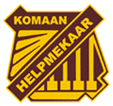Helpmekaar Kollege
| Helpmekaar Kollege | |
|---|---|
 |
|
| Address | |
|
cnr. Empire Road and Melle Street, Parktown Johannesburg, Gauteng South Africa |
|
| Coordinates | 26°11′23″S 28°02′00″E / 26.1898°S 28.0334°E |
| Information | |
| Type | Private High School |
| Motto | Komaan |
| Established | 1921 |
| Headmaster | Klaus König |
| Grades | 8 - 12 |
| Enrollment | 960+ |
| Colour(s) | Dark-brown and gold |
| Houses | Empire, Melle, Smuts |
| Website | www |
Helpmekaar Kollege is an Afrikaans private high school in Braamfontein, Johannesburg, Gauteng, South Africa.
Helpmekaar was the first Afrikaans school in Johannesburg. The school was started by a group of Afrikaners who wanted their children to have an alternative to English schools. The school was officially started in 1921 in the Irene Church opposite the Union Ground. Construction of the school started on 19 September 1925 with the foundation stone being laid by General Barry Hertzog. The land was donated by the Johannesburg City Council at Milner Park, Braamfontein. The slogan of the school "KOMAAN" was derived from a poem by Jan F. E. Celliers by the same title. The school badge was designed by a matric pupil of 1925, A.J. Lessing.
Literally translated 'Komaan Helpmekaar' means 'come on, help each other'.
The Helpmekaar Campus is situated on the corner of Empire and Melle Street, Braamfontein, Johannesburg.
The school building consists of 3 parts: The old building (with the clock tower on top), the newer buildings and the terraces.
The school also has a rugby field, uniform shop, 3 tennis courts, 2 netball practice courts, 2 halls, a swimming pool and a boarding house.
Helpmekaar follows the IEB curriculum. Subjects offered include:
Pupils are also given the opportunity to write the SAT, a standardised college admission test used in the United States, in Grade 11.
The school offers a wide variety of extracurricular activities including:
Sports
Cultural
Academic
Helpmekaar's school uniform has a style that forms part of the school's traditions and past. The basic uniform mainly consists of a brown blazer with a khaki jersey and white shirt, brown tie and khaki trousers or shorts for boys and a khaki dress for girls. Boys always wear caps, while girls always wear bashers. Girls do not have to wear ties during summer (except matrics; see below) and in winter they are allowed to wear long khaki pants or dark tights.
...
Wikipedia
